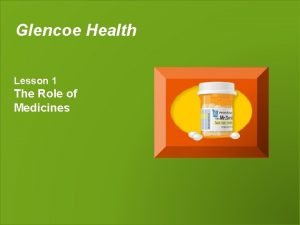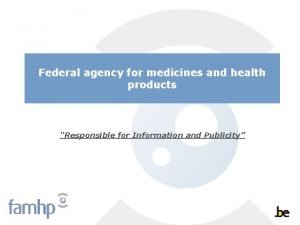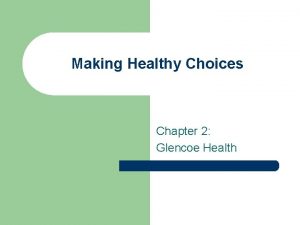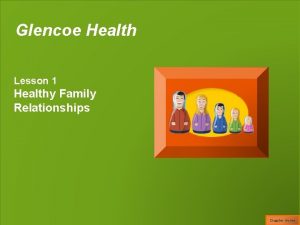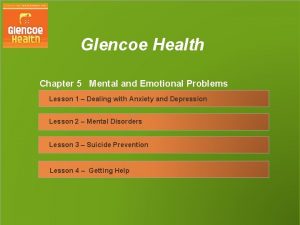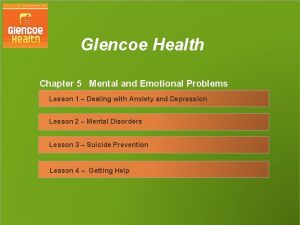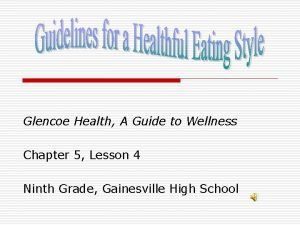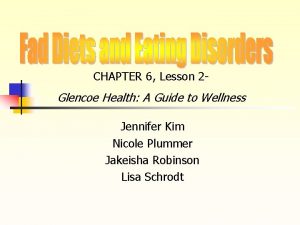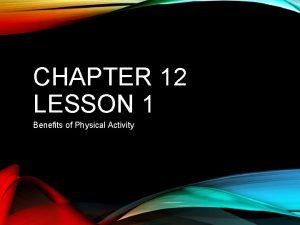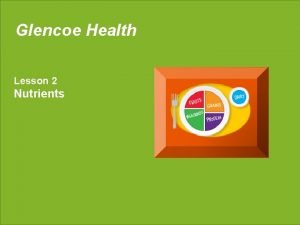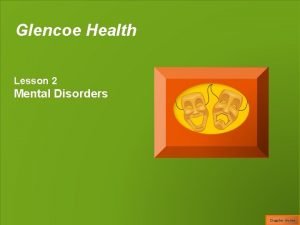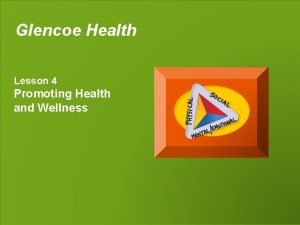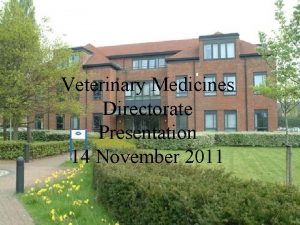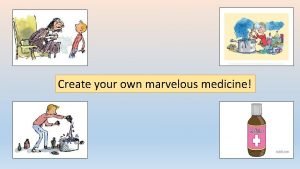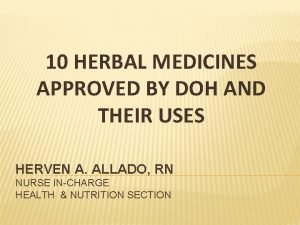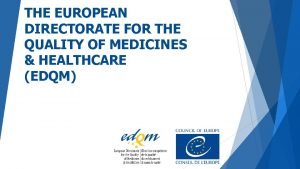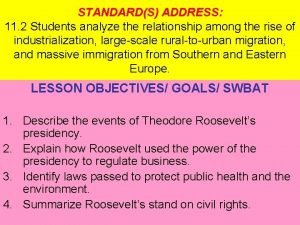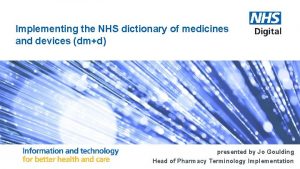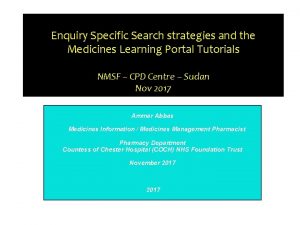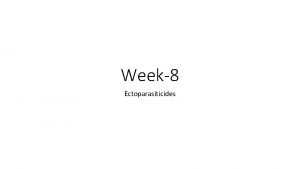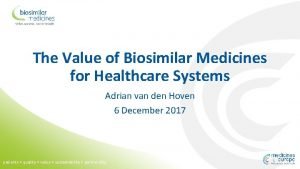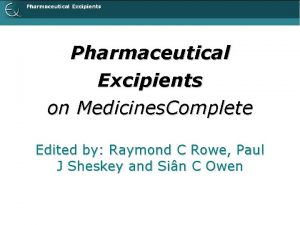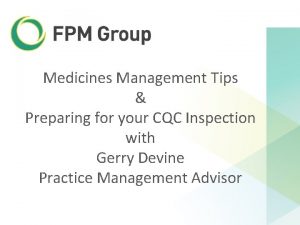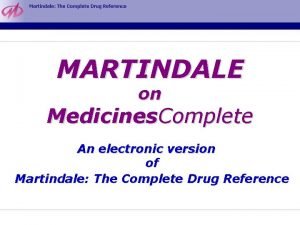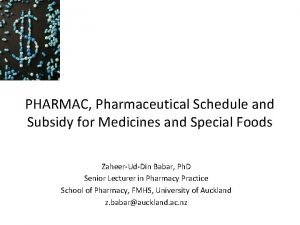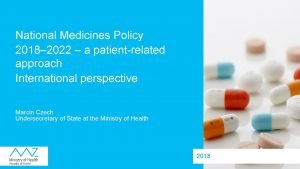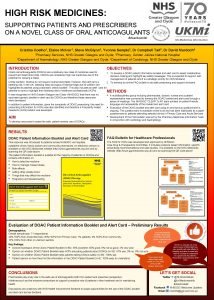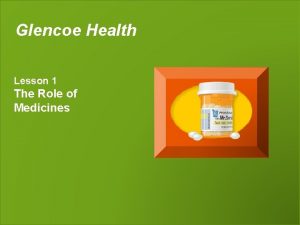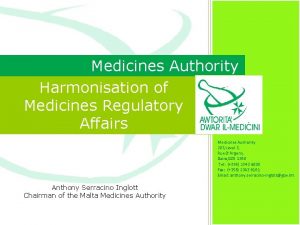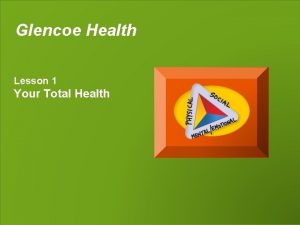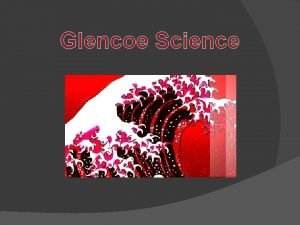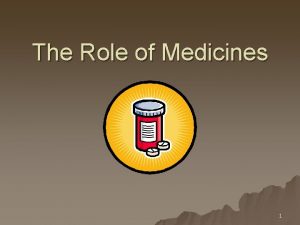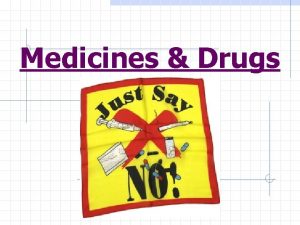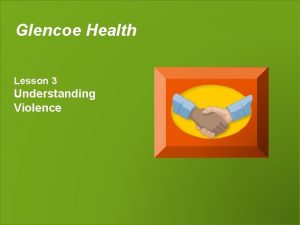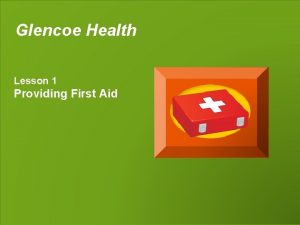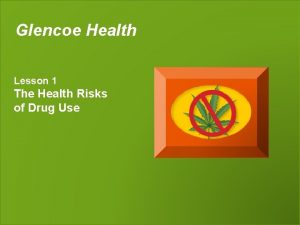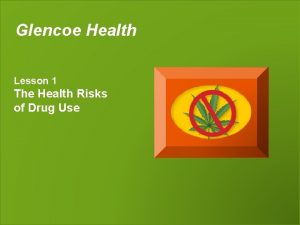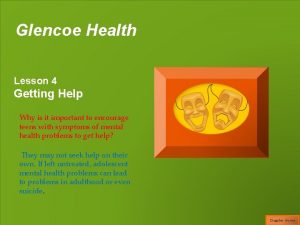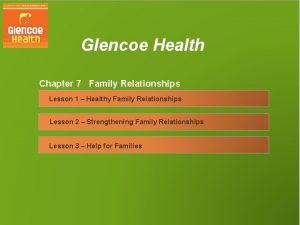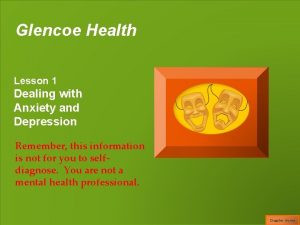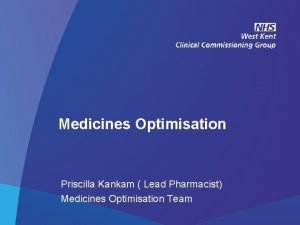Glencoe Health Lesson 1 The Role of Medicines






































- Slides: 38

Glencoe Health Lesson 1 The Role of Medicines

LESSON 1 The Role of Medicines BIG IDEA Medicines are divided into classes and have different effects on different people. New Vocabulary medicines additive interaction drugs synergistic effect vaccine antagonistic interaction side effects Glencoe Health Chapter 19 Medicines and Drugs Lesson Home

LESSON 1 The Role of Medicines Types of Medicines Main Idea Medicines are classified based on how they work in your body. People use medicines to help restore their health when they are ill. Why would medicines have different effects on different people? Each person’s body is unique. As a result, a medicine may work for one person and not another. Glencoe Health Chapter 19 Medicines and Drugs Lesson Home

LESSON 1 The Role of Medicines Types of Medicines All medicines are drugs, but not all drugs are medicines. New Vocabulary medicines Drugs that are used to treat or prevent diseases or other conditions. Glencoe Health Chapter 19 Medicines and Drugs Lesson Home

LESSON 1 The Role of Medicines Types of Medicines Drugs are effective in treating illness when taken as directed by a physical or according to the label instructions. New Vocabulary drugs Substances other than food that change the structure or function of the body or mind. Glencoe Health Chapter 19 Medicines and Drugs Lesson Home

LESSON 1 The Role of Medicines Types of Medicines Four Categories of Medicines that Treat or Prevent Illness Medicines that prevent disease Medicines that fight pathogens Medicines that relieve pain and other symptoms Medicines that manage chronic conditions, help maintain or restore health, or regulate body systems Glencoe Health Chapter 19 Medicines and Drugs Lesson Home

LESSON 1 The Role of Medicines Preventing Disease Today, we have medicines that prevent disease. About 95 percent of children receive vaccines. New Vocabulary vaccine A preparation that prevents a person from contracting a specific disease. Glencoe Health Chapter 19 Medicines and Drugs Lesson Home

LESSON 1 The Role of Medicines Vaccines contain weakened or dead pathogens that cause the disease. When injected into your body, the vaccine produces antibodies that fight those pathogens. Glencoe Health Chapter 19 Medicines and Drugs Lesson Home

LESSON 1 The Role of Medicines Vaccines Your body also produces memory cells that recall how to make these antibodies. This provides you with long-lasting protection against these specific pathogens. What is one of the major arguments that people have against some vaccines? (i. e. the flu vaccine) They don’t work…. . They get you sick…. allergic reactions……religious objections…. etc. Glencoe Health Chapter 19 Medicines and Drugs Lesson Home

LESSON 1 The Role of Medicines Antitoxins prevent disease and neutralize the effects of toxins. Antitoxins fight the bacteria that produce substances toxic to the body. Glencoe Health Chapter 19 Medicines and Drugs Lesson Home

LESSON 1 The Role of Medicines Fighting Pathogens Medicines can also help your body fight the pathogens that cause illness. Glencoe Health Chapter 19 Medicines and Drugs Lesson Home

LESSON 1 The Role of Medicines Antibiotics are a class of drug that destroy diseasecausing microorganisms, called bacteria. Antibiotics work either by killing harmful bacteria in the body or by preventing bacteria from reproducing. Glencoe Health Chapter 19 Medicines and Drugs Lesson Home

LESSON 1 The Role of Medicines Antibiotics The bacteria that antibiotics kill have adapted to the drug over time. Bacteria can develop a resistance to antibiotics when antibiotics are overused. Glencoe Health Chapter 19 Medicines and Drugs Lesson Home

LESSON 1 The Role of Medicines Antibiotics When a doctor prescribes antibiotics, you should follow the doctor’s directions and take all of the pills, otherwise: l you may not kill all of the bacteria. l the remaining bacteria may develop a resistance, or immunity, to the antibiotic. Glencoe Health Chapter 19 Medicines and Drugs Lesson Home

LESSON 1 The Role of Medicines Antivirals and Antifungals Antiviral drugs are used to treat some viral illnesses, such as the flu. These drugs suppress the virus, but do not kill it. Like bacteria, viruses can develop a resistance to medications. Glencoe Health Chapter 19 Medicines and Drugs Lesson Home

LESSON 1 The Role of Medicines Antivirals and Antifungals Fungi are another type of pathogen that can infect the body. Antifungals can suppress or kill fungus cells, such as athlete’s foot and ringworm. Glencoe Health Chapter 19 Medicines and Drugs Lesson Home

LESSON 1 The Role of Medicines Relieving Pain The most commonly used medicines are analgesics, or pain relievers. Aspirin is used to relieve pain and reduce fever. Other analgesics fight inflammation, or redness, swelling, and pain. Glencoe Health Chapter 19 Medicines and Drugs Lesson Home

LESSON 1 The Role of Medicines Relieving Pain Children, teens, and young adults under age 20 should never be given aspirin when they have a fever. Taking aspirin with a fever can lead to Reye’s syndrome is a potentially life-threatening illness of the brain and liver. Glencoe Health Chapter 19 Medicines and Drugs Lesson Home

LESSON 1 The Role of Medicines Pain Reliever Dependence Certain types of medicines that relieve pain can be addictive. These medicines, usually called narcotics, require a doctor’s prescription. Glencoe Health Chapter 19 Medicines and Drugs Lesson Home

LESSON 1 The Role of Medicines Managing Chronic Conditions Some medicines are used to treat chronic conditions. These medicines maintain or restore health, and offer people with chronic diseases a higher level of wellness. Glencoe Health Chapter 19 Medicines and Drugs Lesson Home

LESSON 1 The Role of Medicines Allergy Medicines Antihistamines reduce allergy symptoms such as sneezing, itchy or watery eyes, and a runny nose. They block the chemicals released by the immune system that cause an allergic response. Glencoe Health Chapter 19 Medicines and Drugs Lesson Home

LESSON 1 The Role of Medicines Body-Regulating Medicines Diabetes medicines Regulate the amount of sugar in the blood. Asthma medicines Control symptoms and prevent attacks. Cardiovascular medicines Regulate functions of the cardiovascular system. Glencoe Health Chapter 19 Medicines and Drugs Lesson Home

LESSON 1 The Role of Medicines Antidepressant and Antipsychotic Medicines Medications can also help people suffering from mental illnesses. These medicines can help regulate brain chemistry, or stabilize moods. Glencoe Health Chapter 19 Medicines and Drugs Lesson Home

LESSON 1 The Role of Medicines Cancer Treatment Medicines Some medicines are used to treat cancer. These medicines can reduce rapid cell growth and help stop the spread of cancer cells. Glencoe Health Chapter 19 Medicines and Drugs Lesson Home

LESSON 1 The Role of Medicines Taking Medications Main Idea Medicines enter the body in a variety of ways. Factors that determine how a medicine is taken include what the medicine is used for, and how it will most quickly and effectively help a person. Glencoe Health Chapter 19 Medicines and Drugs Lesson Home

LESSON 1 The Role of Medicines Taking Medications Oral Medicines Taken by mouth Topical Medicines Applied to the skin Inhaled Medicines Delivered in a fine mist or powder Injected Medicines Delivered through a shot Glencoe Health Chapter 19 Medicines and Drugs Lesson Home

LESSON 1 The Role of Medicines Taking Medications help many people with conditions such as asthma and diabetes live active, normal lives. Glencoe Health Chapter 19 Medicines and Drugs Lesson Home

LESSON 1 The Role of Medicines Reactions to Medications Main Idea The effect of medicine depends on many factors. Medicines can have a variety of effects. Glencoe Health Chapter 19 Medicines and Drugs Lesson Home

LESSON 1 The Role of Medicines Reactions to Medications Some side effects may be mild, such as drowsiness, but others may be more severe, and can even cause death. New Vocabulary side effects Reactions to medicine other than the one intended. Glencoe Health Chapter 19 Medicines and Drugs Lesson Home

LESSON 1 The Role of Medicines Body-Regulating Medicines Medicine labels include important information about possible side effects and interactions. Additive Interaction Types of Medicine Interactions Synergistic Effect Antagonistic Interaction Glencoe Health Chapter 19 Medicines and Drugs Lesson Home

LESSON 1 The Role of Medicines Medicine Interactions One example of an additive interaction is when an anti-inflammatory and a muscle relaxant are prescribed to treat joint pain. New Vocabulary additive interaction When medicines work together in a positive way. Glencoe Health Chapter 19 Medicines and Drugs Lesson Home

LESSON 1 The Role of Medicines Medicine Interactions When one medicine increases the strength of another, it is a synergistic effect. New Vocabulary synergistic effect The interaction of two or more medicines that result in a greater effect than when each medicine is taken alone. Glencoe Health Chapter 19 Medicines and Drugs Lesson Home

LESSON 1 The Role of Medicines Medicine Interactions When one medicine decreases the strength of another, it is an antagonistic interaction. New Vocabulary antagonistic interaction The effect of one medicine is canceled or reduced when taken with another medicine. Glencoe Health Chapter 19 Medicines and Drugs Lesson Home

LESSON 1 The Role of Medicines Tolerance and Withdrawal Tolerance is a condition in which the body becomes used to the effect of a medicine. Withdrawal occurs when a person stops using a medicine on which he or she has become physiologically dependent. Glencoe Health Chapter 19 Medicines and Drugs Lesson Home

LESSON 1 Review The Role of Medicines After You Read Reviewing Facts and Vocabulary 1. Define the term medicine and the term drugs. Medicines are drugs that are used to treat or prevent diseases or other conditions. Drugs are substances other than food that change the structure or function of the body or mind. Glencoe Health Chapter 19 Medicines and Drugs Lesson Home

LESSON 1 Review The Role of Medicines After You Read Reviewing Facts and Vocabulary 2. What types of medicines fight pathogens? What types of medicines prevent disease? Antibiotics, antitoxins, antivirals, and antifungals fight pathogens; vaccines and antitoxins prevent disease. Glencoe Health Chapter 19 Medicines and Drugs Lesson Home

LESSON 1 Review The Role of Medicines After You Read Reviewing Facts and Vocabulary 3. Compare a synergistic effect with an antagonistic interaction. A synergistic effect causes the effect of one medicine to be greater, while an antagonistic interaction reduces or cancels the effect of one medicine. Glencoe Health Chapter 19 Medicines and Drugs Lesson Home

Glencoe Health End of Chapter 19 Medicines and Drugs Lesson 1 The Role of Medicines Lesson Home
 Chapter 19 lesson 1 the role of medicines
Chapter 19 lesson 1 the role of medicines Chapter 1 understanding health and wellness lesson 2
Chapter 1 understanding health and wellness lesson 2 Understanding your health and wellness chapter 1
Understanding your health and wellness chapter 1 Chapter 3 lesson 2 health
Chapter 3 lesson 2 health Federal agency for medicines and health products
Federal agency for medicines and health products Glencoe health chapter 2
Glencoe health chapter 2 Chapter 7 lesson 1 healthy family relationships
Chapter 7 lesson 1 healthy family relationships Glencoe health chapter 5 assessment answers
Glencoe health chapter 5 assessment answers Chapter 5 lesson 4 mental and emotional problems
Chapter 5 lesson 4 mental and emotional problems Chapter 5 lesson 3 suicide prevention answer key
Chapter 5 lesson 3 suicide prevention answer key Glencoe chapter 5
Glencoe chapter 5 Chapter 6 glencoe health
Chapter 6 glencoe health Chapter 12 lesson 2 improving your fitness
Chapter 12 lesson 2 improving your fitness Chapter 12 lesson 2 improving your fitness
Chapter 12 lesson 2 improving your fitness Texture repair glencoe
Texture repair glencoe Glencoe health chapter 2 review answers
Glencoe health chapter 2 review answers Glencoe health and wellness
Glencoe health and wellness Role of community health nurse in occupational health
Role of community health nurse in occupational health Veterinary medicines directorate
Veterinary medicines directorate Staff of marvelous medicines
Staff of marvelous medicines Refrigerant management program
Refrigerant management program Advantages of individual prescription order system
Advantages of individual prescription order system Health benefits of niyog-niyogan
Health benefits of niyog-niyogan European directorate for the quality of medicines
European directorate for the quality of medicines What legislation helped solve dangerous food and medicines
What legislation helped solve dangerous food and medicines Nhs dictionary of medicines and devices
Nhs dictionary of medicines and devices Stockley’s drug interaction
Stockley’s drug interaction Ectoparasiticides veterinary medicines
Ectoparasiticides veterinary medicines Abasagar
Abasagar Medicines complete
Medicines complete Cqc medicines management
Cqc medicines management Medicines information centre
Medicines information centre Medicines complete
Medicines complete Pharmac pharmaceutical schedule
Pharmac pharmaceutical schedule National medicines policy
National medicines policy Ggc medicines
Ggc medicines Lesson 1 your total health
Lesson 1 your total health C# azure worker role example
C# azure worker role example Krappmann modell
Krappmann modell
